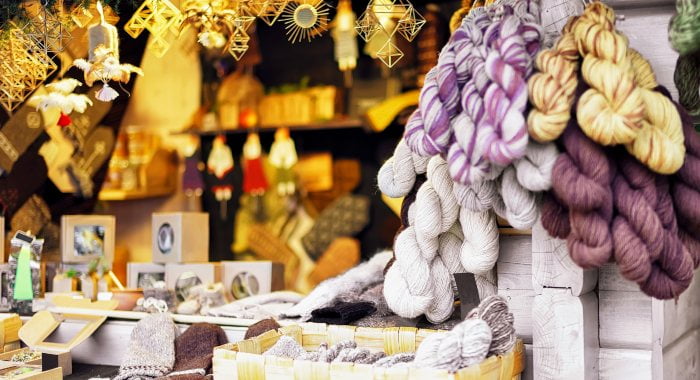If knitting is your thing, and you’re ready to leave the day job and spend your days pursuing your passion, then a knitting business will be the right call for you.
And what an exciting venture that will be! Knitting all day long, being your own boss and making money from your passion.
However, starting your own business can be a daunting task, with a lot of admin, hidden costs and surprises that you need to prepare for. We don’t want to put you off – but make sure that you have all the facts, advice and insight to make your dream into a reality.
So, before you get those needles ready, let’s explore all the facts you need on how to start a knitting business.
Is a knitting business profitable?
Firstly, let’s address some worries about whether knitting is a profitable business idea. The simple answer here is yes.
Knitting can be a great business to start, particularly if you find a unique niche and demographic in the market to stand out.
Although it’s unlikely you will turn into Bill Gates and start a yarn mafia, knitting does have a few advantages up its sleeve.
This is a low overhead compared to other businesses, as you don’t need to rent an office or workstation to knit.
You can do that almost everywhere (including the comfort of your sofa!). What’s more, your startup costs will remain relatively low, as you only need to cover necessary needles, yarn and some other essentials to get up and running.
Just bear in mind that with any business, there will always be a risk.
Unfortunately, 1 in 5 businesses fail in the UK within their first year. It’s a sad fact but also avoidable if you research, prepare and work hard. And that’s what we’re here for – to help you overcome the fear of failure and become fully prepared to start the best knitting business possible.
How to start a knitting business
At Business4Beginners, we believe that there are three key phases to starting a business.
- First is the preparation phase. It’s where you make all the important decisions about what your business will be, what you will do, and make a plan of action to follow. Think of it as writing a knitting pattern for your business.
- Second is the registration phase. This is where you get all the admin and official paperwork completed to become an official sole trader or limited company.
- And finally, you have the trading phase. This is where you start running your business day-to-day, knit all your wares and sell them for a profit!
Seems simple, right? Let’s cover each phase in a little more detail.
Starting A UK Business?
Get rid of the confusion and always know what to do next with Startup Hive, the step-by-step platform created by the Business4Beginners team.
- FREE Step-By-Step Platform
- FREE Company Formation
- FREE Bookkeeping Software
- FREE Bank Account
- FREE Domain Name
- FREE Email Platform
- Plus Much, Much More!

Join today for 100% FREE access to the entire Plan & Establish phases, taking you from validating your business idea through to setting it up, getting your accounts sorted, and creating a website.
“Excellent guide to build your business”
“The perfect starting point”
“Incredibly simple and intuitive to use”
Startup Hive is your trusted companion as you look to turn all of your business dreams into reality. Join today for free.
—
How to start a knitting business: preparation
The preparation phase is all about making important decisions about what your business will do, who your audience is and how you will run it. Then, you’ll get all the answers into a single document called a business plan.
Knitting patterns tell you exactly what you’re making, the materials you’ll need and clear, step-by-step instructions on how to make it. A business plan does the same.
But making a business plan can sound overwhelming. So, let’s break it down into key questions and decisions you must make.
1. What are you going to sell?
This is the core of your business. Here, you need to decide what your knitting business will sell. Will you specialise in:
- Knitting patterns so others can make your creations?
- Custom orders, so people commission you for knitting work?
- Clothes and accessories?
- Toys and decorations?
- Knitting kits for people to DIY at home?
- A subscription knitting kit?
There are a lot of different paths you can take your knitting business down – with pros and cons of each. But ultimately, it will depend on what you enjoy making and what you can realistically achieve.
It might be tempting to pick one or two items on this list, but the reality is that you won’t be able to commit the time and effort to make both work right away.
When starting out, pick a niche. See what works, then expand if there’s demand and space.
2. Who are you selling to?
Now you know what knitting wares you are selling, you need to think about who your customers will be.
Will you be selling to:
- Young, fashion-conscious people who want trendy knitwear to wear?
- New parents who want homemade toys for their little ones to play with?
- Children who want to pick up a new hobby?
- Working adults looking for a mindful activity to learn on their breaks?
- Movie nerds, who are crazy for knitted replicas of costumes?
- Over 60s who love the memories hand-knitted items give them?
Your products and the people you want to sell to will influence most of how your business is run – and how you’ll reach out to them.
But as well as understanding your audience, you must also look at what businesses and products already exist. This will be your competition.
Look at what they’re doing well, how they structure their pricing and ultimately – where there are any gaps that you can jump in and win customers.
It’s an important step in knowing how to start a knitting business, especially for a beginner like you. Your competition can provide you with one of the most important assets: information.

3. Where are you going to sell your knitting?
You have a product. You have an audience. So, how are you going to get your knitwear into their hands?
There are a couple of different options that you can take here, including using online marketplaces like Etsy. The advantages of using sites like Etsy that is that it’s quick and easy to set up, and millions of people are already on the app searching for products like yours.
If you’re planning on selling digital patterns, Etsy also allows people to automatically download files after purchase, making it a great way to gain income without putting too much work in.
However, sites like Etsy do take a small fee per item you sell, so you do need to factor this into the pricing.
If you want to sell online but with more control, you could create your own website and storefront. However, you’ll have to drive all the traffic there yourself, which might not be the best option when you’re just starting out.
If building a website is for you, why not check out our reviews of the best website builders for small businesses?
Alternatively, you could sell your items in person through craft fairs or partnering with local craft shops.
Craft fairs usually have a set fee to enter, but give you a chance to talk to customers, let them try items on and see the quality for themselves. Plus, you’ll save on shipping costs – as long as you don’t mind setting up and travelling part (and sitting on your bum for a few hours!).
4. What is your USP?
A USP is a Unique Selling Point. It’s a way of saying what makes your knitting business different and why customers should choose you over others.
There are lots of different USP options for a knitting business, including:
- That you only use natural dyes and organic fibres for your yarn
- That you partner with local or speciality yarn suppliers
- Create niche patterns that aren’t available anywhere else
- Have a different style that no one else has on the market
Whatever it is, it needs to be a part of what makes you you.
5. How will you price your products?
Price is a key point of creating your business. As much as you might enjoy knitting, there’s no point setting up a business if it won’t make you any money. And to get profit, you need to make sure that the price is right.
So, how do you get to the right price? There’s no correct number here, but to get close, we’d recommend finding out the following information before guessing a price:
- How much do materials cost for each item?
- How much time does it take for you to make each item?
- Are you paying a fee to sell them on online marketplaces or craft stores?
- How many years did it take you to perfect your craft (this does matter, trust us)?
- What are competitors pricing products at?
- How does the quality of your product differ from your competitors?
At a bare minimum, you should charge enough to cover the materials, time and experience you put into each creation. But at the same time, you might feel pressure to charge less to attract customers.
But if you’re basing your price against others, it’s important to remember your USP and the quality on offer. If your product is superior and uses only organic yarn, then don’t be afraid to charge more for it.
6. What startup costs do you need?
We mentioned earlier that starting a knitting business has relatively little overhead. But that doesn’t mean your startup cost will be zero.
Before you start a business, you should think about costs such as:
- Yarn, and where you plan to source it from
- Needles, other equipment or accessories (like safety eyes, buttons, zippers).
- Packaging material and boxes if you plan to ship your items
- Table decorations if you plan to sell at craft markets
- Accounting software to keep track of your finances
- Website costs if you plan to build your own website
Once you have a lift of costs, you need to think about how you will finance it. Some people may be able to finance it using personal savings or lending from family or friends.
If you are considering applying for finance, either through loans, grants or other funding – you will need to create a detailed finance report in your business plan.
Speaking of, it’s time to move on to that exact thing.
7. Get it all down in a business plan
Now, take all the answers you supplied earlier and get them all down into a single document. This is your business plan and will be your guiding light going forward.
If the idea of getting it all on paper is overwhelming, we have the perfect solution to prevent you from unravelling.
Startup Hive, from the makers of Business4Beginners, has a free business plan tool that you can use to create a business plan in minutes. All you need to do is fill in the blanks (using the information you’ve already worked out here!), and you’re good to go.
Registration: making your knitting business official
The preparation phase is the hardest one. So, with that out of the way and a clear idea of what you are doing, it’s time to make it official.
The next big step in knowing how to start a knitting business is to pick a company structure and register with HMRC. Although there are multiple company structures that you could choose from, the main two options for startups are usually between a sole trader and a limited company.
A sole trader is the simplest option that requires the least paperwork.
Fundamentally, all you need to do to register as a sole trader is to let HMRC know that you’ll manage your taxes through Self-Assessment. It’s easy and simple but does come with the least amount of protection.
As a sole trader, you and your company are one and the same. You are solely responsible for it, so any debts or losses the company makes will be your personal debts and losses.
If you want more protection for your business, you can register as a limited company.
A limited company is classified as its own legal entity, which means that it can enter contracts, take out finances and debts, own property, etc., under the business name – not yours.
Although you do have more protection, there are many more legal hoops you have to jump through before you have an official business.
Which Company Formation Package Is Right For You?
Answer 5 multiple choice questions to get a personal recommendation:
To set up a limited company, you’ll need a unique company name, a business address, a director (which can be you), and assigned shares.
You’ll also need certain official documents to register with Companies House. If that sounds like a lot, you can always use the help of company formation agents to set up your business for you.
If you’re undecided between a sole trader and a limited company, find out more about the differences between the two company structures here.
However, it can be helpful to remember that this choice doesn’t have to be permanent. It’s easy to set up as a sole trader while you get started, then transition into a limited company once you’re established and will benefit from the added security.
Needles at the ready! It’s time to trade
Congratulations on creating your business plan and registering your knitting business! Now comes the fun part: knitting and running your business daily.
This also means it’s time to launch marketing plans to bring customers in and get those sales.
There are many different ways to market a knitting business, with different avenues for the type of audience you’re going after (and thanks to your business plan, you know exactly who that is!).
However, to get you started, here’s some inspiration:
1. Get on the gram
Social media is a great tool for businesses, and Instagram is a great fit for showcasing crafts and knitwear.
To get the most from social media, you’ll want to try consistent posts of high-quality images – while experimenting with different content styles like behind-the-scenes videos or fun tutorials.
2. Partner with influencers
Partnering up with influencers or bloggers in the knitting and fashion world is a great way to widen your audience.
And when we say influencers, we don’t mean mega-rich celebrities – but key people your audience already follows or relates to. For example, if you’re after the young, fashion-conscious demographic, a fashion blogger specialising in knitwear would be a great partner!
3. Don’t neglect in-person events
Even if you decide to sell goods online instead of craft fairs, these events can be great one-offs to help expand your reach and get your name out there.
If you’re doing these events, we’d also recommend having a card with links to your website, storefront or social media so people can follow you or share with friends and family.
Top-Rated Company Formation Agents
| Formation Agent | Cheapest Package | Add On Services | Our Rating | Review | Official Site |
|---|---|---|---|---|---|
 | £52.99 | Excellent | 9.4 | Read Review | Visit Website |
 | £51.99 | Excellent | 9.4 | Read Review | Visit Website |
 | £50 | Average | 9.4 | Read Review | Visit Website |
Keep calm and carry yarn: how to start a knitting business
One last piece of advice: take a deep breath and take things a step at a time. We’ve gone through a lot in this guide, but this plan will get you through the entire setup and creation of your business. It was not designed to be done in a day.
So, take it step by step. Take your time to figure things out and plan properly. But when it’s time – don’t be afraid to take the leap and start bringing your creations to life.
And remember: For the best support and insider tips, sign up to Startup Hive.
Dreamed up by the brilliant minds at Business4Beginners, Startup Hive buzzes with the latest business gossip, expert advice, nifty tips, and easy-peasy guides to ignite your entrepreneurial adventure!







